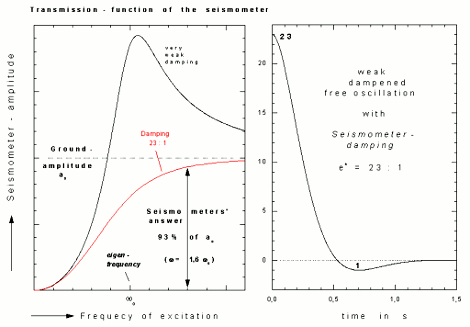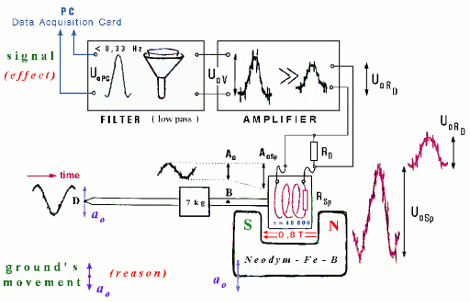5.1 The journey of signals from the ground to the computer 1/2
Earthquake waves set the ground in motion. This movement causes the pendulum's suspension and the magnet of the seismometer to move which in the case of our teaching seismograph are both fixed to the frame, which in turn is placed on the ground. In the case of the stationary seismometers of our station the suspension and the magnet are securely fixed to the building. Each pendulum however is not statically bound to the ground but is - as described above - suspended by several wires. Therefore it inertly follows the movement of the ground.
The journey of a signal from the ground to the hard-drive disk of a PC is outlined in this next illustration.
The amplitude of the ground's movement relative to an inertial frame
will be known asa0.
Da bei Fernbeben die Erdbewegung sehr langsam ist, sieht es
für uns so aus, als ob sich das Pendel bewegt.
At point B on the pendulum ('centre of movement') one can imagine the entire mass of the pendulum at one point. The distance D to B is therefore the reduced length of the pendulum. So the centre of movement B moves relative to the laboratory with displacement A0, which is constantly somewhat smaller than the ground displacement a0, conditional to a properly damped seismometer (see following illustration).

Fig.43: Transfer function for the seismometer displacement for two differing strengths of damping vs. free oscillation of the seismometer in the case of 'seismograph damping'.
Coaxially to the pendulum's boom we have fixed a coil with many turns of wire (circa 40,000). This induction coil is situated within a strong magnet (0.8 Tesla) on one side. Such magnets are easily available and not too expensive.
As the coil has a longer lever than the centre of movement, the displacement AoSp is slightly larger at the coil than at B (indicator-enlargement). In the coil that is moving we now have an electric current, exactly as is the case in a bicycle dynamo. One can therefore determine an electrical voltage Uo at the coil that is proportional to the velocity of the movement of coil and magnet relative to each other.
Because of the electrical current that flows in the coil, a magnetic field is generated around it. This magnetic field however acts against the field of the permanent magnet ('Lenz' rule'). In this manner the movement of the coil and with it the movement of the pendulum is damped.
This effect is comparable to the electric brakes of a streetcar. The damping of the seismometer's pendulum can easily be tuned with the help of a damping resistor RD, which is switched parallel to the induction coil.
The electrical working-signal is also measured at this damping resistor. An amplifier finally enhances this weak signal. However, as well as amplifying the signal, one also amplifies the background noises, such as produced by passing vehicles or students walking and running in the vicinity.
Therefore the amplified signal Uov is fed through a filter where all frequencies higher than 0.33 Hz are removed. The amplified and cleaned signal UPC can now be saved in the PC for future examination.
